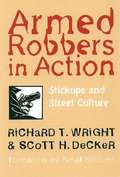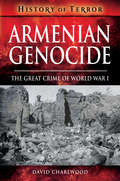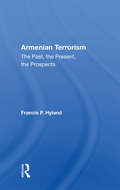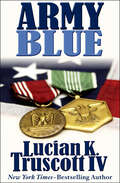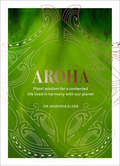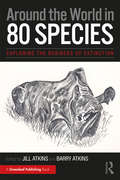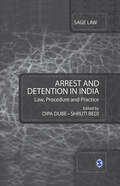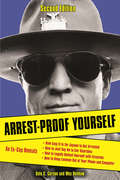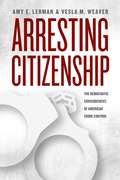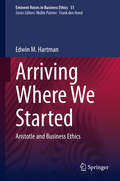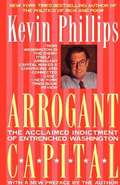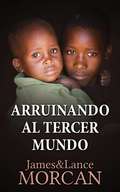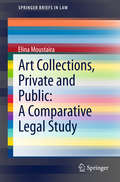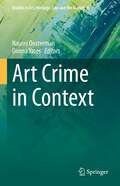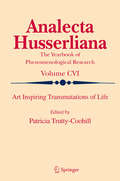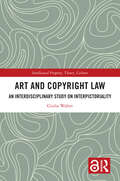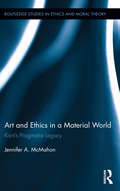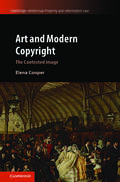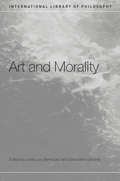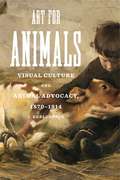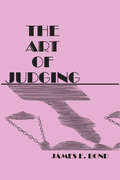- Table View
- List View
Armed Robbers in Action: Stickups and Street Culture
by Richard T. Wright Scott H. DeckerOne of the most feared crimes among urban dwellers, armed robbery poses a serious risk of injury or death, and presents daunting challenges for law enforcement. Yet little is known about the complex factors that motivate assailants who use a weapon to take property by force or threat of force. Armed Robbers in Action is not like previous studies that focus on the often distorted accounts of incarcerated offenders. Richard T. Wright and Scott H. Decker conducted dangerous, life-threatening field research on the streets of St. Louis to obtain more forthright responses from robbers about their motives and methods. They also visited several crime scenes to examine how situational and spatial features of the setting contributed to the offense. Quoting extensively from their conversations with the offenders, the authors consider the circumstances underlying the decision to commit an armed robbery, explore how and why targets are chosen, and detail the various tactics used in a hold-up. By analyzing the criminals' candid perspectives on their actions and their social environment, the authors provide a fuller understanding of armed robbery. They conclude with an insightful discussion of the implications of their findings for crime prevention policy.
Armenian Genocide: The Great Crime of World War I (History of Terror)
by David CharlwoodThis short history sheds light on the slaughter and expulsion of ethnic Armenians during WWI with stories of those who witnesses the terror firsthand. Twenty years before the start of Hitler&’s Holocaust, over 1.5 million Armenians were murdered by the Turkish state. They were crammed into cattle trucks and deported to camps, shot and buried in mass graves, or force-marched to death. It was described as a crime against humanity and Turkey was condemned by Russia, France, Great Britain and the United States. But two decades later the genocide had been conveniently forgotten. Hitler justified his Polish death squads by asking in 1939: &‘Who after all is today speaking about the destruction of the Armenians?&’ In Armenian Genocide, historian David Charlwood presents a gripping short history of a forgotten genocide. With vivid eyewitness accounts, this volume recalls the men and women who died, the few who survived, and the diplomats who tried to intervene.
Armenian Terrorism: The Past, The Present, The Prospects
by Francis P HylandArising seemingly out of nowhere, Armenian terrorist groups in the last two decades have carried out over 200 attacks in some two dozen countries around the world. Although this wave of terror at first appears to have sprung up without warning, a closer look at Armenian history, especially since World War I, shows that it is only the most recent in a series of outbreaks of ethnic violence. In this study, the author examines the social and political background of Armenian terrorism and its similarities to and differences from other terrorist movements, and he carefully dissects the organizational methods of these groups. An important feature of the work is an extensive and detailed chronology of Armenian terrorism from 1915 to the present. Each entry provides essential information concerning the date and time of the attack, location, victims, weapons used, terrorist groups and individual commandos responsible for the attack, and a list of sources for further reference. A resource for specialists studying terrorism and ethnic violence, "Armenian Terrorism" should also be useful to those interested in the tragic and difficult history of Armenia and Turkey.
Arming and Disarming
by R. Blake BrownFrom the École Polytechnique shootings of 1989 to the political controversy surrounding the elimination of the federal long-gun registry, the issue of gun control has been a subject of fierce debate in Canada. But in fact, firearm regulation has been a sharply contested issue in the country since Confederation. Arming and Disarming offers the first comprehensive history of gun control in Canada from the colonial period to the present.In this sweeping, immersive book, R. Blake Brown outlines efforts to regulate the use of guns by young people, punish the misuse of arms, impose licensing regimes, and create firearm registries. Brown also challenges many popular assumptions about Canadian history, suggesting that gun ownership was far from universal during much of the colonial period, and that many nineteenth century lawyers - including John A. Macdonald - believed in a limited right to bear arms.Arming and Disarming provides a careful exploration of how social, economic, cultural, legal, and constitutional concerns shaped gun legislation and its implementation, as well as how these factors defined Canada's historical and contemporary 'gun culture.'
Army Blue
by Lucian K. Truscott IVFrom the bestselling author of Dress Gray. &“Part-war story, part-family saga . . . zeroes in on the men of the Blue family, three generations of soldiers&” (The Washington Post). In the eagerly anticipated follow-up to his first novel, Dress Gray, Truscott turns his attention to the Vietnam War and delivers a suspenseful, sprawling court-martial drama set in Saigon in 1969. At twenty-three, platoon leader Lt. Matthew Nelson Blue is the youngest member of an army family; his father is a colonel and his grandfather a profane, cantankerous retired general. Shortly after one of his men is killed by friendly fire while on routine patrol, Blue is arrested and charged with desertion in the face of the enemy. Arriving in Vietnam, his father and grandfather end their long estrangement and join forces to clear the young soldier&’s name. Truscott&’s plot offers less than initially meets the eye; the nature of the conspiracy and cover-up that nearly destroy Blue is fairly easy to predict, as is the disillusionment about Vietnam that eventually befalls his seniors. The author&’s intimate portrayal of the texture of army life gives his narrative a more deeply felt sense of anger and regret than others in its genre, and makes its final revelations more powerful than they might otherwise have been.
Aroha: Maori wisdom for a contented life lived in harmony with our planet
by Hinemoa ElderAs seen on Oprah's Book Club! The #1 New Zealand Bestseller! Discover how to live a happier life - simple, traditional wisdom for difficult modern times.Aroha is an ancient Maori word and way of thinking. Maori psychiatrist Dr Hinemoa Elder explores how Aroha can help us all by sharing 52 thought-provoking whakatauki, traditional Maori life lessons - one for each week of the year.Discover how we can all find greater contentment and kindness for ourselves, each other and our world by understanding how we might invite the values of Aroha into our daily lives.Ki te kotahi te kakaho ka whati, ki te kapuia, e kore e whati.When we stand alone we are vulnerable but together we are unbreakable.
Around the World in 80 Species: Exploring the Business of Extinction
by Jill Atkins Barry AtkinsThe world is currently experiencing a sixth period of mass species extinction, and extinction of flora and fauna is caused by a variety of factors arising from industrial activity and increasing human population, such as global warming, climate change, habitat loss, pollution and use of pesticides. Most causes of extinction are linked to corporate activity, either directly or indirectly. Around the World in 80 Species: Exploring the Business of Extinction responds to the ongoing mass extinction crisis engulfing our planet by exploring the ways in which accounting, business and finance can be used to prevent species extinctions. From Africa to the Far East and from Europe to the Americas, the authors explore species loss and how businesses can stop mass extinctions through greater transparency, and through closer engagement with their investors and wildlife organisations. The book concludes that global capitalism has led us to this extinction crisis and that therefore the mechanisms of capitalism – namely accounting, finance, investment – can help to pull us out. Businesses must urgently address extinction before it is too late for all species, including ourselves. As the first book to explore corporate accounting and accountability in relation to species on the brink of extinction, this book will be of great interest to both professionals and a wider audience interested in the causes and prevention of extinction.
Arrest and Detention in India: Law, Procedure and Practice (SAGE Law)
by Dipa Dube Shruti BediHuman rights enshrined in the Constitution of India protect Indian citizens against misuse of powers by the State and its functionaries. However, detainee rights are often neglected in custody. Arrest and Detention in India: Law, Procedure and Practice critically examines arrest and detention laws in India, focusing on constitutional guarantees and criminal jurisprudence. The book studies legislations that have invited much criticism from human rights activists, such as the Code of Criminal Procedure (CrPC), Unlawful Activities (Prevention) Act (UAPA), Armed Forced (Special Powers) Act (AFSPA) and Narcotic Drugs and Psychotropic Substances Act (NDPS). It explores topical areas such as inter-state arrests, juvenile crime, remand and detainee rights. This book evaluates the controversial powers of arrest and detention, arguing for stricter regulation in terms of the international, constitutional and human rights mandates. The book examines public safety and whether it can be implemented through legal standards that compromise personal liberty.
Arrest and Provisional Detention: The Obligations of the UAE under Article 14 of the Arab Charter on Human Rights
by Mohammad Al-Haddad Al-HattawiArrest and Provisional Detention: The Obligations of the UAE under Article 14 of the Arab Charter on Human Rights By Mohammad Alhaddad Alhattawi This thesis explores the compatibility of UAE law on arrest and provisional detention with Article 14 ArCHR. Given the lack of any report by the UAE on the measures which they have taken to give effect to the rights recognised in the ArCHR and the absence of effective institutions under the ArCHR to provide authoritative interpretation of the Charter’s Articles, this thesis advances an interpretation of Article 14, drawing on the interpretation of Article 9 ICCPR under the HRC and Article 5 ECHR under ECtHR. In the case of the ICCPR, this is because the wording is similar and it is a universal instrument to which some parties to the Arab Charter are also parties. In the case of the ECHR, it is because the words are similar and the Strasbourg Court has considered aspects of the interpretation and application of those provisions in a number of contexts. This considered interpretation will be of assistance to decision makers in the UAE and other parties to the ArCHR.
Arrest-Proof Yourself
by Wes Denham Dale CarsonThis essential "how not to" guide explains how to act and what to say in the presence of police to avoid unnecessary arrests for petty offenses or mistakes in judgment that can lead to permanent disqualification from jobs, financing, and education. From what to do if a cop asks to search the car to dealing with a racial slur or how to handle a roach in the ashtray, this handbook details the nuances of dealing with the police. This revised and expanded edition of Arrest-Proof Yourself includes more than 100 pages of new information to reflect changes in police technique and "proactive policing." More than 50 pages are dedicated to weaponry--including how to legally own and handle guns and knives and which firearms to use for self-defense--and updates examine topics such as the current surveillance state and the ability of police to track movements and activities using data drawn from cell phones and computers. Sprinkled with not only moral outrage but also the weird humor that permeates law enforcement, this urgent, eye-opening exposé has stories from 30 years of case files, making it the go-to guide to police procedures for all Americans.
Arrested: What to Do When Your Loved One's in Jail
by Wes DenhamWhether a defendant is charged with misdemeanor disorderly conduct or first-degree murder, this is an indispensable guide for those who want to support family members, partners, or friends facing criminal charges. Draining away the confusion by explaining legal proceedings and jail procedures, it identifies common bond scams and lawyer rip-offs and helps organize inmates to assist in their legal defense. In addition to the most common legal motions, challenges, and investigations, this resource also provides additional coverage on how to avoid fights, sex, gambling, and scams that can result in injury while in jail and cause additional criminal charges to be filed. Detailed budgeting forms to calculate the true, multiyear costs of legal defense--all the way through the years of probation, parole, and reentry into society--are also included.
Arresting Citizenship: The Democratic Consequences of American Crime Control
by Vesla M. Weaver Amy E. LermanThe numbers are staggering: One-third of America’s adult population has passed through the criminal justice system and now has a criminal record. Many more were never convicted, but are nonetheless subject to surveillance by the state. Never before has the American government maintained so vast a network of institutions dedicated solely to the control and confinement of its citizens. A provocative assessment of the contemporary carceral state for American democracy, Arresting Citizenship argues that the broad reach of the criminal justice system has fundamentally recast the relation between citizen and state, resulting in a sizable--and growing--group of second-class citizens. From police stops to court cases and incarceration, at each stage of the criminal justice system individuals belonging to this disempowered group come to experience a state-within-a-state that reflects few of the country’s core democratic values. Through scores of interviews, along with analyses of survey data, Amy E. Lerman and Vesla M. Weaver show how this contact with police, courts, and prisons decreases faith in the capacity of American political institutions to respond to citizens’ concerns and diminishes the sense of full and equal citizenship--even for those who have not been found guilty of any crime. The effects of this increasingly frequent contact with the criminal justice system are wide-ranging--and pernicious--and Lerman and Weaver go on to offer concrete proposals for reforms to reincorporate this large group of citizens as active participants in American civic and political life.
Arriving Where We Started: Aristotle and Business Ethics (Issues in Business Ethics #51)
by Edwin M. HartmanEdwin Hartman offers an account of his intellectual journey from Aristotle to organization theory to business ethics to an Aristotelian approach to business ethics. Aristotle’s work in metaphysics and psychology offers some insights into the explanation of behavior. Central to this sort of explanation is characteristically human rationality. Central to successful organizations is characteristically human sociability. That human beings are by nature rational and sociable is the basis of Aristotle’s ethics. Though a modern organization is not a polis in Aristotle’s sense, it has good reason to treat people as rational and sociable on the whole, and thereby to preserve the organization as a commons of people linked by something much like Aristotle’s account of strong friendship. Organizations that are successful in this respect, particularly those that deal with a nationally diverse workforce, may offer a far-reaching and attractive model.
Arrogant Capital: Washington, Wall Street, and the Frustration of American Politics
by Kevin PhillipsEveryone knows that Washington is completely out of touch with the rest of the country. Now Kevin Phillips, whose bestselling books have prophesied the major watersheds of American party politics, tells us why. Washington - mired in bureaucracy, captured by the money power of Wall Street, and dominated by 90,000 lobbyists, 60,000 lawyers, and the largest concentration of special interests the world has ever seen - has become the albatross that Thomas Jefferson and our other Founding Fathers feared: a swollen capital city feeding off the country it should be governing. Throughout most of our history, the genius of American politics was that ballot revolutions every generation swept out failed establishments and created new ones. Now that can no longer happen. Feared and even hated by a majority of the citizenry, "Permanent Washington" has dug in. Using history as a chilling warning, Kevin Phillips parallels the present atrophy to that of formerly mighty and arrogant capitals like Rome, Madrid, and Amsterdam.,Unchecked, Washington will - like other great powers before it - lead the country to its inevitable decline and fall. To work again, Washington must be purged and revitalized. In his unique blueprint for a political upheaval, Kevin Phillips puts Washington on notice by sounding a cry for immediate action, offering us a wide variety of remedies - some quasi-revolutionary, others more moderate, but all sure to be controversial.
Arruinando al Tercer Mundo
by Marcela Gutiérrez Bravo y Luis Arturo Sánchez James Morcan Lance Morcan"Arruinando al Tercer Mundo" está dedicado a los pobres en lugares olvidados del mundo. Cuestiona si instituciones como el Banco Mundial, el Fondo Monetario Internacional, la Agencia de los Estados Unidos para el Desarrollo Internacional y otras grandes organizaciones de ayuda internacional en verdad rescatan o hunden a la gente más pobre del mundo. Este libro también cuestiona si la ayuda provista es genuina o si se trata de una estafa diseñada para subyugar a los países del Tercer Mundo. Expone la cultura de la corrupción dentro de las mencionadas organizaciones de ayuda y la arrogancia con que tratan a sus “clientes” del tercer mundo. Los Morcan revelan que hay una agenda oculta y vil en juego, donde la “generosidad” extendida por organizaciones de ayuda internacional para asistir al desarrollo del Tercer Mundo y proveer alivio en la eventualidad de desastres naturales no sea caridad, sino egoísmo, con varios hilos atados... hilos diseñados para esquilar naciones vulnerables. El lector encontrará al popular Sicario Económico John Perkins y encontrará que su bestseller “Confesiones de un Sicario Económico” es vigente, particularmente en África. Al escribir este libro, los autores fueron motivados por unas estadísticas escalofriantes: 21,000 personas mueres de hambre cada día. ¡Eso es una persona cada cuatro segundos! Más escalofriante es el hecho de que tales muertes son innecesarias, dado que hay más que suficiente riqueza en el mundo para que todos cubran, al menos, las necesidades básicas de la vida, y más que el Tercer Mundo se sostenga orgánicamente a sí mismo. Para cuando termines este libro, verás que hay tanta riqueza en el Tercer Mundo, como en el Primero. De hecho, términos como “Tercer Mundo” y “naciones pobres” están, esencialmente, equivocados, ya que implican que la riqueza y los recursos son limitados en estos lugares.
Art Collections, Private and Public: A Comparative Legal Study (SpringerBriefs in Law)
by Elina MoustairaThis book is a comparative legal study of the private and public art collections in various states of the world, covering the most important issues that usually arise and focusing on the differences and the similarities of the national laws in the treatment of those issues.
Art Crime in Context (Studies in Art, Heritage, Law and the Market #6)
by Donna Yates Naomi OostermanThis book brings together empirical and theoretical case-study research on art and heritage crime. Drawn from a diverse group of researchers and professionals, the work presented explores contemporary conceptualisations of art crime within broader contexts. In this volume, we see ‘art’ in its usual forms for art crime scholarship: in paintings and antiquities. However, we also see art in fossils and in violins, chairs and jewellery, holes in the ground and even in the institutions meant to protect any, or all, of the above. And where there is art, there is crime. Chapters in this volume, alternatively, zoom in on specific objects, on specific locations, and on specific institutions, considering how each interact with the various conceptions of crime that exist in those contexts. This volume challenges the boundaries of what we understand as “art and heritage crimes” and displays that both art, and criminality related to art, is creative and unpredictable.
Art Inspiring Transmutations of Life (Analecta Husserliana #106)
by Patricia Trutty CoohillAlthough the creative impulse surges in revolt against everyday reality, breaking through its confines, it makes pacts with that reality's essential laws and returns to it to modulate its sense. In fact, it is through praxis that imagination and artistic inventiveness transmute the vital concerns of life, giving them human measure. But at the same time art's inspiration imbues life with aesthetic sense, which lifts human experience to the spiritual. Within these two perspectives art launches messages of specifically human inner propulsions, strivings, ideals, nostalgia, yearnings prosaic and poetic, profane and sacral, practical and ideal, while standing at the fragile borderline of everydayness and imaginative adventure. Art's creative perduring constructs are intentional marks of the aesthetic significance attributed to the flux of human life and reflect the human quest for repose. They mediate communication and participation in spirit and sustain the relative continuity of culture and history.
Art and Copyright Law: An Interdisciplinary Study on Interpictoriality (Intellectual Property, Theory, Culture)
by Giulia WalterThis book tackles the lack of synchronicity between art and copyright law, proposing practical and interdisciplinary tools through which to navigate this conflict.In the last decades, high profile lawsuits have been filed against artists accused of plagiarism including Jeff Koons, Barbara Kruger and Andy Warhol. This book demonstrates how these cases are at odds with contemporary artistic reality, in which the use of antecedent visual forms is common practice. Focusing on the dichotomies of “original/copy” and of “old/new”, this work addresses this phenomenon from both theoretical and legal perspectives. Using Swiss copyright law as the main case study, the book comparatively assesses other international legal frameworks. Through understanding the origins of the conflict between art and copyright, the book highlights solutions to handle copyright cases with a new methodological approach.The book will be of interest to researchers in the field of art and copyright law, intellectual property and art.The Open Access version of this book, available at http://www.taylorfrancis.com, has been made available under a Creative Commons Attribution-Non Commercial-No Derivatives (CC BY-NC-ND) 4.0 license.
Art and Ethics in a Material World: Kant’s Pragmatist Legacy (Routledge Studies in Ethics and Moral Theory)
by Jennifer A McMahonIn this book, McMahon argues that a reading of Kant’s body of work in the light of a pragmatist theory of meaning and language (which arguably is a Kantian legacy) leads one to put community reception ahead of individual reception in the order of aesthetic relations. A core premise of the book is that neo-pragmatism draws attention to an otherwise overlooked aspect of Kant’s "Critique of Aesthetic Judgment," and this is the conception of community which it sets forth. While offering an interpretation of Kant’s aesthetic theory, the book focuses on the implications of Kant’s third critique for contemporary art. McMahon draws upon Kant and his legacy in pragmatist theories of meaning and language to argue that aesthetic judgment is a version of moral judgment: a way to cultivate attitudes conducive to community, which plays a pivotal role in the evolution of language, meaning, and knowledge.
Art and Modern Copyright: The Contested Image (Cambridge Intellectual Property and Information Law #47)
by Elena CooperThis book is the first in-depth and longitudinal study of the history of copyright protecting the visual arts. Exploring legal developments during an important period in the making of the modern law, the mid-nineteenth to early twentieth centuries, in relation to four themes - the protection of copyright 'authors' (painters, photographers and engravers), art collectors, sitters and the public interest - it uncovers a number of long-forgotten narratives of copyright history, including views of copyright that differ from how we think today. As well as considering the distinct nature of the contribution of copyright to the history of the cultural domain accounted for by scholars of art history and the sociology of art, this book examines the value to lawyers and policy-makers today of copyright history as a destabilising influence: in taking us to ways of thinking that differ from our own, history can sharpen the critical lens through which we view copyright debates today.
Art and Morality (International Library Of Philosophy Ser.)
by Sebastian GardnerFeaturing contributions from Matthew Kieran, Aaron Ridley, Roger Scruton and Mary Mothersill to name but a few, this collection of groundbreaking new papers on aesthetics and ethics, highlights the link between the two subjects. These leading figures tackle the important questions that arise when one thinks about the moral dimensions of art and the aesthetic dimension of moral life.The volume is a significant contribution to philosophical literature, opening up unexplored questions and shedding new light on more traditional debates in aesthetics. The topics explored include:the relation of aesthetic to ethical judgment the relation of artistic experience to moral consciousnessthe moral status of fictionthe concepts of sentimentality and decadencethe moral dimension of critical practice, pictorial art and musicthe moral significance of tragedythe connections between artistic and moral issues elaborated in the writings of central figures in modern philosophy, such as Kant, Schopenhauer and Nietzsche.The contributors share the view that progress in aesthetics requires detailed study of the practice of criticism. This volume will appeal to both the philosophical community and to researchers in areas such as literary theory, musicology and the theory of art.
Art for Animals: Visual Culture and Animal Advocacy, 1870–1914 (Animalibus)
by J. Keri CroninAnimal rights activists today regularly use visual imagery in their efforts to shape the public’s understanding of what it means to be “kind,” “cruel,” and “inhumane” toward animals. Art for Animals explores the early history of this form of advocacy through the images and the people who harnessed their power.Following in the footsteps of earlier-formed organizations like the RSPCA and ASPCA, animal advocacy groups such as the Victoria Street Society for the Protection of Animals from Vivisection made significant use of visual art in literature and campaign materials. But, enabled by new and improved technologies and techniques, they took the imagery much further than their predecessors did, turning toward vivid, pointed, and at times graphic depictions of human-animal interactions. Keri Cronin explains why the activist community embraced this approach, details how the use of such tools played a critical role in educational and reform movements in the United States, Canada, and England, and traces their impact in public and private spaces. Far from being peripheral illustrations of points articulated in written texts or argued in impassioned speeches, these photographs, prints, paintings, exhibitions, “magic lantern” slides, and films were key components of animal advocacy at the time, both educating the general public and creating a sense of shared identity among the reformers.Uniquely focused on imagery from the early days of the animal rights movement and filled with striking visuals, Art for Animals sheds new light on the history and development of modern animal advocacy.
Art for Animals: Visual Culture and Animal Advocacy, 1870–1914 (Animalibus: Of Animals and Cultures #12)
by J. Keri CroninAnimal rights activists today regularly use visual imagery in their efforts to shape the public’s understanding of what it means to be “kind,” “cruel,” and “inhumane” toward animals. Art for Animals explores the early history of this form of advocacy through the images and the people who harnessed their power.Following in the footsteps of earlier-formed organizations like the RSPCA and ASPCA, animal advocacy groups such as the Victoria Street Society for the Protection of Animals from Vivisection made significant use of visual art in literature and campaign materials. But, enabled by new and improved technologies and techniques, they took the imagery much further than their predecessors did, turning toward vivid, pointed, and at times graphic depictions of human-animal interactions. Keri Cronin explains why the activist community embraced this approach, details how the use of such tools played a critical role in educational and reform movements in the United States, Canada, and England, and traces their impact in public and private spaces. Far from being peripheral illustrations of points articulated in written texts or argued in impassioned speeches, these photographs, prints, paintings, exhibitions, “magic lantern” slides, and films were key components of animal advocacy at the time, both educating the general public and creating a sense of shared identity among the reformers.Uniquely focused on imagery from the early days of the animal rights movement and filled with striking visuals, Art for Animals sheds new light on the history and development of modern animal advocacy.
Art of Judging: Volume 8
by James. E BondThe single most important issue in American constitutional law is the role the Supreme Court should play in interpretation of the constitution. This issue has been a source of controversy since at least 1803, when Chief Justice John Marshall proclaimed that the Supreme Court could declare acts of Congress unconstitutional. But public attention has been refocused by the recent debate between Attorney General Edwin Meese and Supreme Court Justice William Brennan. The Attorney General admonished the Justices to confine themselves to strict construction of the Constitution-to apply the Constitution as the framers intended. Justice Brennan rejected this as errant and arrogant because the framers had certainly not thought about the specific problems facing the country today.
